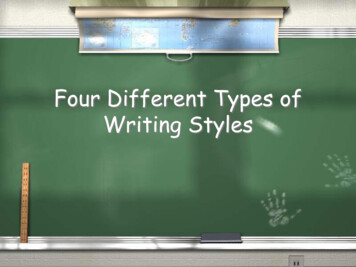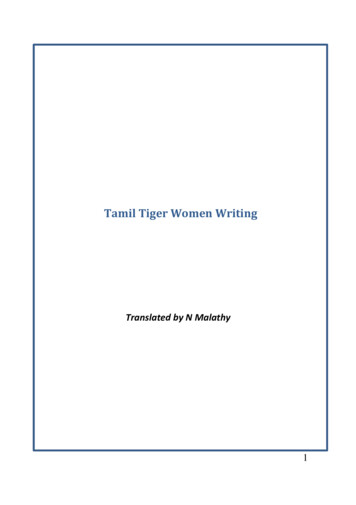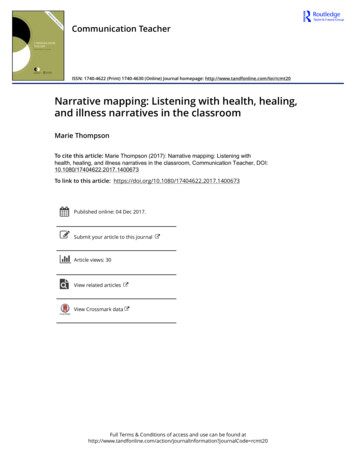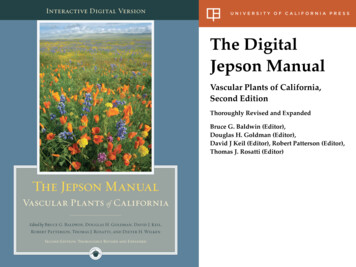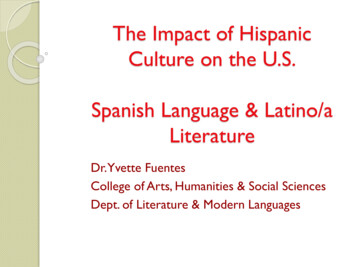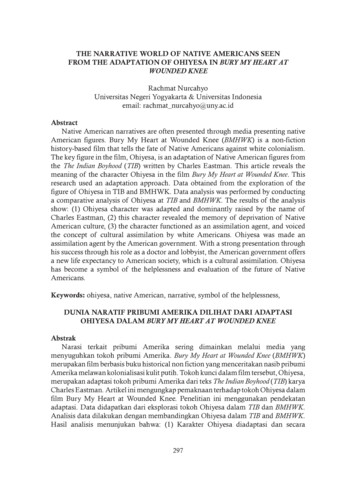
Transcription
THE NARRATIVE WORLD OF NATIVE AMERICANS SEENFROM THE ADAPTATION OF OHIYESA IN BURY MY HEART ATWOUNDED KNEERachmat NurcahyoUniversitas Negeri Yogyakarta & Universitas Indonesiaemail: rachmat nurcahyo@uny.ac.idAbstractNative American narratives are often presented through media presenting nativeAmerican figures. Bury My Heart at Wounded Knee (BMHWK) is a non-fictionhistory-based film that tells the fate of Native Americans against white colonialism.The key figure in the film, Ohiyesa, is an adaptation of Native American figures fromthe The Indian Boyhood (TIB) written by Charles Eastman. This article reveals themeaning of the character Ohiyesa in the film Bury My Heart at Wounded Knee. Thisresearch used an adaptation approach. Data obtained from the exploration of thefigure of Ohiyesa in TIB and BMHWK. Data analysis was performed by conductinga comparative analysis of Ohiyesa at TIB and BMHWK. The results of the analysisshow: (1) Ohiyesa character was adapted and dominantly raised by the name ofCharles Eastman, (2) this character revealed the memory of deprivation of NativeAmerican culture, (3) the character functioned as an assimilation agent, and voicedthe concept of cultural assimilation by white Americans. Ohiyesa was made anassimilation agent by the American government. With a strong presentation throughhis success through his role as a doctor and lobbyist, the American government offersa new life expectancy to American society, which is a cultural assimilation. Ohiyesahas become a symbol of the helplessness and evaluation of the future of NativeAmericans.Keywords: ohiyesa, native American, narrative, symbol of the helplessness,DUNIA NARATIF PRIBUMI AMERIKA DILIHAT DARI ADAPTASIOHIYESA DALAM BURY MY HEART AT WOUNDED KNEEAbstrakNarasi terkait pribumi Amerika sering dimainkan melalui media yangmenyuguhkan tokoh pribumi Amerika. Bury My Heart at Wounded Knee (BMHWK)merupakan film berbasis buku historical non fiction yang menceritakan nasib pribumiAmerika melawan kolonialisasi kulit putih. Tokoh kunci dalam film tersebut, Ohiyesa,merupakan adaptasi tokoh pribumi Amerika dari teks The Indian Boyhood (TIB) karyaCharles Eastman. Artikel ini mengungkap pemaknaan terhadap tokoh Ohiyesa dalamfilm Bury My Heart at Wounded Knee. Penelitian ini menggunakan pendekatanadaptasi. Data didapatkan dari eksplorasi tokoh Ohiyesa dalam TIB dan BMHWK.Analisis data dilakukan dengan membandingkan Ohiyesa dalam TIB and BMHWK.Hasil analisis menunjukan bahwa: (1) Karakter Ohiyesa diadaptasi dan secara297
dominan dimunculkan dengan nama Charles Eastman, (2) Karakter ini mengungkapmengungkap memori perampasan budaya pribumi Amerika, (3) karakter tersebutdifungsikan sebagai agen asimilasi, dan menyuarakan konsep asimilasi budaya olehkulit putih Amerika. Ohiyesa dijadikan agen asimilasi oleh pemerintah Amerika.Dengan pemaparan kuat melalui keberhasilan dia melalui perannya sebagai doktersekailgus pelobi parlemen, pemerintah Amerika menawarkan harapan hidup barukepada pribumi Amerika, yaitu sebuah asimilasi budaya. Ohiyesa telah menjadisimbol dari ketakberdayaan dan gambaran masa depan pribumi Amerika.Kata kunci: Ohiyesa, pribumi Amerika, narasi, simbol ketakberdayaanINTRODUCTIONBecause of the great role of memoryin transforming commitments andresponsibilities from earlier eras (Poole,2008), the study of memory has beenexcellent in cultural studies. The beliefthat memory is increasingly useful instudying humans and culture is gettingstronger (Hermann, 2009; Harris, 2010).This makes many experts agree that thememory of an event can be built by theappearance of the work. The memoryof human work manifests in the form ofnarratives and myths that are believedby both individuals and groups (Ferry,2009).The study of film based on historicalstories is a study of narrative worldof a community. Understanding thehistory of a people can be understoodby searching in the film which partstelling about the people. Film, in fact,can be a site that invites viewers toremember and even repeat historywith representation techniques (Sonja,2007). This technique, according to PaulGrainge (2003: 1), places the study ofcinema in the study of modern culture.Because the technology used in filmproduction is believed to be capable ofphotographing past events, the film isconsidered as a work that contains the298 LITERA, Volume 19, Nomor 2, Juli 2020politics of memory (Grainge, 2003:97).The relationship between theAmerican government and NativeAmericans is hegemonic, i.e. onecontrols the other. The Americangovernment regards itself as the rulerof indigenous life so that it justifiesitself to regulate the natives. In otherwords, the American government wasplaced as the party that colonized andthe natives were the colonized party.The process of interaction of thecolonizer and the colonized are in aspace between. This space shows thedifferences of the two parties, markingtheir position, their relationship, andat the same time becoming a place ofnegotiation (Bhabba, 2000).Although the study of Americanhistory is increasingly developing anddiscussing the broad alignment ofthe rights of people in America, thememory of certain groups still leavesproblems. For example, the emergenceof stereotypes of Native Americanswhich Cothran (2015) calls the conceptof cultural continuity. Cothran (2015)shows a strong example of the present,namely the incident when Osama BinLaden was killed by a special Americansoldier. The code used when informing
the death was, ‘Geronimo, Geronimo,E.K.I.A (Enemy Killed in Action).The use of ‘Geronimo’ for murderousexpressions reinforces the stereotype ofthe relationship between the Americangovernment and Native Americans interms of violence. The visualizationof the example of violence continueson the American concept of empireof innocence, namely America whichwas built with the story of white peoplewho are always the victims or the whitevictimhood.In the above case, the memory ofNative Americans is still struggling withviolence and murder. Moreover, relatedto the memory of Native Americans, theNative American massacre at WoundedKnee was commemorated with a sitethat read, Wounded Knee was officiallydesignated a heroic of brave soldiersover hostile, fanatical, and treacherousGhost Dancers (Harjo, 1997: 13). Readby generation after generation, this isone of the efforts to build memory forWounded Knee. This article presents ananalysis of the narrative world of nativeAmerican seen from the character ofOhiyesa who is adapted as CharlesEastman in the film titled Bury My Heartat Wounded Knee (BMHWK).Ohiyesa is a native of the LakotaSioux tribe. His father, Many Lightning,thinks that his child’s future is only in theschool. Ohiyesa successfully completedher medical school and returned to theNative American community under thename Charles Eastman.The BMHWK film is an adaptationof the final two chapters of the book withthe same title written by Alexander DeeBrown. The initial appearance of thebook caused a debate. Even this debateis part of the construction of memory bythe book. The book is considered to befirmly standing behind the fate of NativeAmericans and voicing the injusticeof the American government towardsNative Americans, especially relatedto the massacre of the Wounded Knee(Fixico, 2009). Although agreeing thatthe BMHWK book is a work that voicedthe interests of Native Americans, thebook was deemed unfit to enter theacademic table due to the inaccuracy ofthe facts displayed (Prucha, 1972). Apartfrom the strong spirit of advocating thebook against Native Americans and theinaccuracy of the writer in compilinghistorical facts, memory politics hasplayed its role. Richardson (2005)calls it a contradiction in framing andnarrative analysis.The memory of Native Americanshas changed. However, the change inmemory of Native Americans still placesthe stereotype of inhumanity. Ferry(2009) proposed the concept of memorychange in Native American history.He formulated three major tribes, TheTongva, The Mohegan, and The Pequotinitially as a memory of community.The arrival of white people with allthe problems that occur, land grabbingand murder, makes the memory ofthe individual who survived, which hecalled a cultural bearer. Then the culturalbearer becomes an asset, which activistshave revived in the form of a museum.This museum is a collective memoryof Native Americans. Collectivememories built with artificial buildingsforce people into the stages of collectiveimagination (Borer, 2010). Collectiveimagination tends to build perceptionsof artifacts that it sees but is orientedtoward the future, not the past. In thiscase, the existence of native AmericansThe Narrative World of Native Americans Seen from the Adaptation of Ohiyesa . 299
is oriented towards certain perceptions.Unfortunately, in many media (films)the image of Native Americans ismore of a rough and uncivilized nature(Basham, 2012). The politics of futureorientation and avoidance of divisionsseem to be a tool of the Americangovernment in controlling NativeAmericans’ memories of their past.American scholars help constructmemories of Native Americans.Their theorization contributed tothe perception and belief in NativeAmericans. Slotkin (2000) describeshis study of literary and media textsfrom colonial times to the 20th century.Interestingly, in his race war exposure, hestated that Colonel George ArmstrongCuster was immortalized as a martyrafter the massacre of the Lakota andCheyenne tribes at Little Bighorn onJune 25 , 1876. On the other hand,Jacoby (2008), in his book Shadowsat Dawn: A Borderlands Massacre andthe Violence of History, reveals that theApache tribe has adapted to Spanishcolonialism by adopting an economicusurpation, which creates hatred amongHispanics and O’odham. Because whitepeople were accused of embezzlementat the Camp Grant Affair, there waswar and massacre in the area. The wayto commemorate the slaughter varies.The Apache dictated their memoriesto ethnologists, built a cultural centerto tell their stories, and inaugurated anannual memorial event to honor thevictims.The BMHWK filmization isinseparable from memory politics. Atleast, the book becomes part of thepolitics of memory. As an artifact, filmhas the same function as a museum thattells the events of the past (Wiersma,300 LITERA, Volume 19, Nomor 2, Juli 20202009: 15). Writing historical facts willnot be able to be at a neutral point, alwaysinfluenced by the author’s orientation.Writing history often does not includevictims who are not well known.Writing and artifacts tend to featurefamous figures (Wiersma, 2009: 18).The BMHWK film is also consideredsuccessful in showing those who diedin the war. However, the book was notable to display those who did not go towar (Iverson, 2001). The adaptationof Ohiyesa in this film is important.Ohiyesa appeared predominantly inthe film as Charles Eastman, a NativeAmerican who had been an academicsuccess. He was incarnated as someonewho deserved or seemed idolized by thenext generation of Native Americans.The transformation of these keycharacters can clearly capture the worldof Native American narratives, fromthe history of violence to the expressedhopes.METHODThis research used an adaptationapproach. The Data resources were thememoir The Indian Boyhood (TIB) and afilm entitled Bury My Heart at WoundedKnee (BMHWK). Both of them depictedthe character of Ohiyesa, a NativeAmerican. This study used descriptivequalitative method. The data needed isobtained by close reading of Ohiyesa’scharacter in books and films. Datarelated to Ohiyesa characters werecollected from observations of thesecharacters in the film. This study treatedBMHWK film as a text. The first step inanalyzing the characters in the text wasin-depth reading. Ohiyesa characterwas examined by looking for historicalsources in the book and compared with
the appearance of the character in thefilm. The next step was interpreting thefindings related to Ohiyesa character.Meaning was linked to the concept ofnative American narratives. The analysisof these findings was the attitude of thetext in presenting Native AmericansRESULT AND DISCUSSIONResultThere were changes in Ohiyesacharacter presentation in The IndianBoyhood and Bury My Heart at WoundedKnee. These changes can be in the formof narrative elimination or addition.Reduction of childhood narrativesand indigenous traditions occurs in thefilm version. Little Ohiyesa is not told.Friction with white civilization alsoincludes additions. BMHWK in detailshows how Ohiyesa met, accepted,and played a role in civilization. Thisdoes not appear in TIB. Changes ofOhiyesa’s narration in the two worksare in Table 1.Table 1. Narartion of Ohiyesa in The Indian Boyhood and Bury My Heart at WoundedKneeNoAspect1Little Ohiyesa2Indian Life3Impression of Civilization4During Wounded Knee MassacreThe Indian BoyhoodRiding horses, playing inthe woods, and huntingfor foodAdventure, Woods,LegendsFirst encounter withtrains and whiteAmerican community-Ohiyesa character is so important.He hovered between two civilizationsthat never meet reconciliation. Heis never being fully identified as anIndian and never being fully identifiedas a white. He is the symbol of theBury My Heat atWounded KneeViolenceWarFirst experience at schoolIntroduction to religionMeeting Elaine Goodale(his wife in future)Becoming a lobbyist anda doctorconflict, which still exists betweenthese two civilizations. The appearanceof Ohiyesa in BMHWK is important,because it acts as a narrative symbol ofnative American life. These appearancesare in table 2.The Narrative World of Native Americans Seen from the Adaptation of Ohiyesa . 301
Table 2. Ohiyesa’s appearances in Bury My Heart at Wounded KneeNo1AspectSaved from the massacreAppearance (min)01:45 - 04:462Meeting with his father3Introduced to cross necklace10.01 - 11:074First experience at school26:18 - 28:085Parted with his father31:59 – 32.006Introduced at the Congress33:10 - 36:447Meeting with Elaine Goodale36:45 – 38:458Toward the reservation01:07:54 - 01:10:19Got a letter from Elaine describingthe sad state of reservation due toillness9Agreement Failure01:32:26 - 01:37:30Native Americans reject all plansby Senator Dawes. Whites arethought to only be driving them10Victim of Wounded Kneemassacre01:48: 25 - 01: 56:56Charles Eastman took care of thevictims of the massacre. There arehundreds of fatalities from NativeAmericans11Future project from thegovernment08:40 - 09:5901:59:50-02:02:41DiscussionThe experience of Ohiyesa wentthrough has symbolic of the nativeAmericans of that period. He was takenfrom his native land by his father whoconverted to Christianity while in prison.He was taken to Christian communityand converted to Christianity. He waseducated in white schools and sent toboarding school. This experience is aportrait of many Native Americans.The discussion on the adaptation ofOhiyesa are as follows.302 LITERA, Volume 19, Nomor 2, Juli 2020DetailsOhiyesa was saved from amassacreHis father conveyed the intentionto bring Ohiyesa to a white schoolOhiyesa was given a cross necklaceby his fatherCutting hair and look for a newgospel-based nameTaken away by train.There is a feather symbol and across necklaceOhiyesa has changed to CharlesEastmanGetting closer and intimatelytelling how he got the nameCharlesCensus of Native Americanchildren by finding names fromthe gospelsOhiyesa to Eastman: Deprivation ofcultureOne of the principal figures in theBMHWK is Charles Eastman, a LakotaSioux also known as Ohiyesa. He wasassimilated into white culture and didvery well through schools. Ohiyesabegan formal education when her fatherenrolled her in a missionary school inFlandreau. He was an intelligent NativeAmerican, who managed to study atDartmouth and finally, he completedmedical school in Boston, graduating
in 1890. Eastman then fought for therights of Native Americans, becamea Washington lobbyist for the DakotaSioux, and was commissioned by TeddyRoosevelt, and Calvin Coolidge tohandle some matters related to NativeAmericans.He writes about his childhood as aNative American, as well as his medicaland political experience, providing aperspective of two extraordinary andunique worlds. Eastman is known forhis appearance in the film Bury Myheart at Wounded Knee. In the bookBMHWK, Eastman did not appear atall. Incorporating Eastman’s characterinto the film provides a differentperspective space. Eastman is no longerknown as Ohiyesa. He is narrated as afigure as well as an object of the successof the white civilization process of thenatives.Charles Eastman is one of the Siouxtribesmen who became the central figurein the BMHWK. Having the first nameOhiyesa, Eastman was taken from theindigenous community and schooledin white educational institutions untilhe could become a doctor. Eastman’srole in the film began when he wasintroduced to the white Americanpublic. Eastman is considered a modelof civilization that is being offered tonatives as well as an assimilation agentused by the American government.In the BMWK, the memory ofcultural appropriation manifests in twoinstitutions, namely school and religion.The school was the initial institution ofdeprivation of Native American culture.Schools are used as agents to educateindigenous children, but with normsthat are believed by whites. Deprivationof culture begins with this institutionand begins with children. Ohiyesa is anative of the Lakota Sioux tribe. By hisfather, Many Lightning, he was takenfrom the Native American communityand placed in a white school. Lightningthinks that his child’s future is only inthe school. However, several scenesin the film show that the indigenousculture of the Sioux has been deprived.The meeting with Lightning at08:40 showed that Ohiyesa rejectedthe new culture brought by her father.He refused to be hugged by his father.That courage was also strengthened bythe visualization of the red shirt he waswearing. The scene of Ohiyesa’s haircutat 37:39 is very powerful exposing thedeprivation of Indian culture. Ohiyesa’sappearance was arranged in a way thatwas in line with the norms adopted bywhites. This scene is a flashback whenadult Ohiyesa (Charles Eastman) sadlytells the story of the discovery of thename Charles. At minutes 26:18 to28:08, Ohiyesa was in the school roomwith a woman who was teaching. Thefirst question asked by the teacherwas the identification of the namesof American Presidents. Only thosewho already have Christian names areallowed to answer.Sioux beliefs have no place. Theentry of Christianity marked thedeprivation of their beliefs. Thereligion entered in conjunction with theschooling process of the children of theSioux tribe. Lightning, at 10:01, startedto introduce Christianity to the LakotaSioux community. He proudly showedthe cross necklace to his friends andassumed that his helper was a religionwith the cross. What’s more, at 30:39when Ohiyesa felt depressed becauseof the burden at her school, LightningThe Narrative World of Native Americans Seen from the Adaptation of Ohiyesa . 303
motivated her by giving Ohiyesa a crossnecklace.Ohiyesa as an agent of assimilationOhiyesa grew up and managedto become a doctor. Ohiyesa is morepersonal with Charles Eastman who isproud of whites as the success of theassimilation process. Eastman appearedwith a white appearance. His acceptancebegan in the 33:10 to 36:44-minutescene when he was introduced to thewhite community. Completely wearinga suit and not forgetting to show thecross necklace, He was admired by thecommunity with a round of applause.The opportunity to make a speech wasused by him to convey the philosophyof Indian language and its translationin English. Extraordinary welcomewith applause after he made a speech.At that time, He met with Elaine, awoman who studied Native Americans.He put his trust in Elaine. From 36:45to 38:45, He told his life story to get thename ‘Charles’ to Elaine.Eastman was directly involved in theplans for the reservation and purchaseof Black Hill land. Together withsenator Dawes, in the minutes 46:57to 48:57, He participated in designingthe plan. In fact, he did the hatchingdirectly to the land projected as a Siouxreservation. From 50:26 to 50:36,members of Congress congratulatedDawes and Eastman on their plan forapproval by all members of Congress.The plan is referred to as a white planwith a touch of Indians.Eastman acts as an assimilationagent. He was used by whites as amodel. The success in Eastman’s life,being an intellectual and a doctor, wasan example that the film wanted to304 LITERA, Volume 19, Nomor 2, Juli 2020present to the audience. The memoryof the Sioux became clear with theemergence of this assimilation agent,that Native Americans could only live ina white way. In addition, the emergenceof Eastman’s assimilation agents alsoreinforces the memory that the failureof native Americans due to traditionallifestyles, and the plans of the Americangovernment regarding native and BlackHill are mature plans that also considerthe fate of the natives. This memory isstrong with Eastman being involved init.The past of Native Americanspresents trauma. The battle againstwhites gave birth to memories of thedeath of the ancestors, and even thedisappearance of certain tribes. Withsuch trauma, the cultural assimilationprogram offered by the Americangovernment. This assimilation waswrapped up in a reservation project inwhich whites could smoothly enter theideas of their civilization. The text ofBMHWK presents past trauma throughthe telling of the rehabilitation and theprograms in it.The theme of cultural assimilationis not very visible in the BMHWKbook. In 19 chapters, this book moreoften portrays the cruelty of Americansoldiers towards the natives. Indulgencein native life was presented as a result ofwhite greed and the defeat of the nativesin various battles. The only descriptionof assimilation in the two texts is theinclusion of the school program in thereservation. Furthermore, the two textsdo not provide an explanation of howthe assimilation took place.The BMHWK film actuallypresents the theme of assimilation asthe dominant theme in its telling. By
taking the character Charles Eastman,this film seems to advocate the USgovernment assimilation project. Thiscan be seen from the description ofthe figure of Charles Eastman and hisinvolvement in assistance programs forNative Americans in the reservation.At the end of the story, the film stronglyfeatures Charles Eastman who receivedthe project of renaming native children.On the contrary, Eastman character isnot displayed in the BMHWK book.As a model of the success of thewhite civilization process, Eastmanaffirmed the alignment of indigenousidentity with whites. Appearing in thewhite public as intellectuals, Eastmanwas physically dressed in a whiteAmerican style. As if to emphasize thathe is a native, he used native language instarting his speech. In other words, thisfilm confirms that a Native Americancan be equal to white Americans. Thisbecame the same as the spirit of thenative character (not in the film) CharlesEastman who campaigned for the totalalignment of Native Americans withwhite citizens through his work entitledFrom the Deep Woods to Civilization (1961).Eastman’s involvement in determiningthe Act with Senator Dawes seemed tostrengthen his position before the whiteAmericans. What’s more, this characteris shown directly to the indigenouscommunity through his involvementin the reservation. He came to givetreatment. Together with an educator,Ealine Godale, he was busy treating sicknatives and even witnessed the ferocityof the Wounded Knee massacre.Eastman is a role model for natives.Eastman’s identity rift is presentedthrough a description of the past thathe always remembers. War violenceand separation from the indigenouscommunity became a traumatic spacefor him. The trauma felt stronger whenhe had to adapt to the educationalenvironment. The scene of how hegot the name Charles was stronglypresented. Even this scene appearedwhen Eastman was talking about hisidentity. The habit of holding a weapon(knife) must change with a stationeryand a cross. The change of trust is noteasy and always a memory for Eastman.He also had a debate with SenatorDawes over the planned purchase ofBlack Hills. His position was firm thatDawes’s plan had never benefited thenatives and would instead destroy them.Eastman’s defense was due to his directinvolvement in observing native life inreservations. However, in the end, hewas unable to stem the efforts of Dawesand the American government. After themassacre at Wounded Knee, Eastmanand Elaine returned to Washington. Atthe congress building, Dawes rescuedhim for carrying out a new task, thecensus of Native Americans. He hadto find a Christian name and give it toall Native American children. He wasdescribed as very frustrated with thetask because the search for Christiannames was a traumatic thing for him.The BMHWK film presents a strongending that affirms the complexityof Eastman’s feelings while offering afuture for the natives. This film showsEastman returning to the river wherehe played as a child. He then took outa bird’s feather and a cross wrapped inanimal skin. He will throw these itemsinto the river. However, he finally savedit. Items such as crosses and bird feathersthat are stored are the embodiment ofthe mission that will be carried by him.The Narrative World of Native Americans Seen from the Adaptation of Ohiyesa . 305
The future of the natives is representedby the union of these goods in the handsof Charles Eastman.The BHMWK presents historicaltrauma for Native Americans. Defeatagainst white expansion resulted inhaving to be eliminated and uprootedfrom their culture. The traumaunderwent a transformation in theBMHWK spacecraft. Both workspresent trauma through a series ofhistorical native-white relationshipsdisplayed through the theme of battle.The BHMWK film shows the traumamore strongly as a personal experienceof a native figure who was not involvedin battle. Personal trauma is framed bythe appearance of success. A mixture ofsuccessful and traumatic imagery waspresented as a future offer for natives.It appears that both books eliminatethe character Charles Eastman, eventhough he is also a perpetrator ofhistory. The BMHWK film includedhim as the main character. The attemptto place Eastman’s character in the filmaffirms the mission of the Americangovernmentregardingculturalassimilation. No matter how bad thetrauma felt to the natives, their future isin the process of assimilation.Telling the painEastman managed to become anassimilation agent by whites. He wasdirectly involved in handling the NativeAmerican problems in the reservation.In the scene 1:07:54, Eastman began hisrole in the reservation and saw firsthandthe conditions of the Native Americans.Beyond the concept of assimilation thatis used as life expectancy for NativeAmericans, disappointment and paincan be seen in Eastman’s character.306 LITERA, Volume 19, Nomor 2, Juli 2020He seemed to reflect the pain of hispeople. The reservation policy also hada violent impact on Native Americans.In addition to poor shelter conditions,Native Americans are limited incarrying out their religious and culturalactivities, and are introduced to thewhite American judicial and lawenforcement system. The shelter isconsidered the beginning of a difficultlife. All the land for herding cattle hasbeen taken by white Americans.Eastman’s disappointment at thefacilities obtained by Native Americansmade him write a letter asking formedication aids. In scenes 01:26:22through 01:29:35, senator Dawes cameto the reservation to proceed with theland purchase plan. He presented theplan and Eastman listened in the backrow. From 01:32:26 to 01:37:30, Dawesdid the same thing but was stricter.He wants a signature of approval anddisapproval. Sitting Bull appears and istrusted again. Together with Red Cloudthey confront Dawes’ plans. Eastmanlistened and saw all the events. Helooked disappointed with Dawes’ plan.From scenes 01:37:31 to 01:40:05, Heargues with Dawes. Eastman felt thatDawes’s plan did not benefit NativeAmericans and would even destroythem. Dawes said that he was alsopressured by the congress. Dawes thinksthat Eastman is no longer an Indian andcannot represent the Sioux. Eastmanloudly said if one of Dawes’s enemieswas him. After the debate, Eastmanlooked sad. In the scene 01:41:57, Helooks serious watching Ghost dance.After the massacre at WoundedKnee Creek, Eastman and Elainereturned to the city. In scenes 01:57:52to 01:59:37, Eastman with a formal suit
met Dawes at the congress building.Dawes greeted him and said that hehad a new mandate. Eastman then wasgiven an assignment in a census projectof Native Americans. He had to find aChristian name and give it to all NativeAmerican children.In the scenes 01:59:50 to 02:02:41,He felt unacceptable with theassignment, he was angry and kicked apile of papers for the project. However,He continued to work. In the scene02:02:42 to 02:05:03, which is also thefinal scene from the film, He was in theriver where he played as a child. Riding,he pulled out feathers, animal skins, andcross necklaces. He plans to throw theseitems into the river. However, he endedup storing the items and returning homeriding across the river.Eastman has a strong role as a coverof memory for Native Americans.After the massacre, this film presentsa scene that does not sympathize withthe massacre. Eastman was asked for aspecial mission, and he lived. The filmbuilds the Native American ‘defeat’memory. Native Americans were‘exhausted’ after the events at WoundedKnee, and what continued was NativeAmericans who lived according towhite norms.Ambivalent attitude toward IndiannessEastman was dominantly presentedas a symbol of the life expectancy ofNative Americans. In other words,Eastman has become a model for thefuture of Native Americans. Therewas an ambivalence of treatment toIndianness when
Wounded Knee. This article presents an analysis of the narrative world of native American seen from the character of Ohiyesa who is adapted as Charles Eastman in the film titled Bury My Heart at Wounded Knee (BMHWK). Ohiyesa is a native of the Lakota Sioux tribe. His father, Many Lightning, thinks that his child's future is only in the



